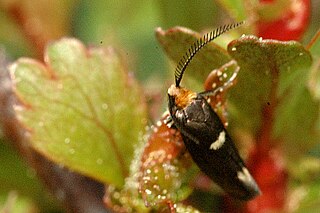
Incurvaria masculella, the feathered leaf-cutter, is a moth of the family Incurvariidae. It is widespread in Europe.
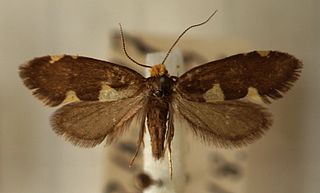
Incurvaria oehlmanniella is a moth of the family Incurvariidae. It is found in Europe and across the Palearctic to eastern Siberia.

Incurvaria pectinea is a moth of the family Incurvariidae. It is found in Europe.

Recurvaria leucatella is a moth of the family Gelechiidae. It is found in most of Europe, Turkey, Central Asia and the Caucasus.

The lobster-clawed moth is a moth of the family Gelechiidae. It is found in most of Europe, except for the Iberian Peninsula and most of the Balkan Peninsula. In the east, the range extends to Siberia and Taiwan.

Monochroa lucidella is a moth of the family Gelechiidae. It is found in most of Europe, except Spain, Switzerland and most of the Balkan Peninsula. It is recorded from the Near East and Siberia (Transbaikalia).

Phylloporia bistrigella is a moth of the family Incurvariidae. It is found in western, northern and central Europe and north-eastern North America.

Stigmella trimaculella is a moth of the family Nepticulidae. It is found in most of Europe, east to the eastern part of Palearctic realm.

Stigmella continuella is a moth of the family Nepticulidae. It is found from Fennoscandia to the Pyrenees, Alps and Hungary, and from Ireland to central Russia and Ukraine, east to the eastern part of the Palearctic realm.

Stigmella nylandriella is a moth of the family Nepticulidae. It is found in all of Europe, east to Russia, where it has been recorded from Bryansk, Murmansk, Karelia, Leningrad and Voronezh.

Ectoedemia argyropeza is a moth of the family Nepticulidae. It is a widespread species, with a Holarctic distribution.

Ectoedemia subbimaculella is a moth of the family Nepticulidae. It is found in most of Europe, east to Smolensk, Kaluganorth and the Volga and Ural regions of Russia.

Ectoedemia occultella, the small birch leafminer, is a moth of the family Nepticulidae. It has a Holarctic distribution. It is found in most of Europe, east through Russia to Japan. It is also present in North America. Mines very similar to that of Ectoedemia occultella have been found on Rosaceae species in Nepal and Japan and these may belong to this species.
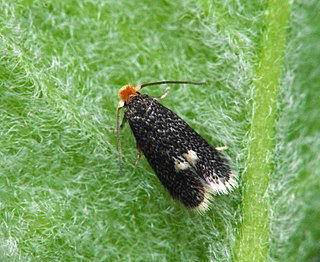
Ectoedemia septembrella is a moth of the family Nepticulidae. It is found in most of Europe, east to the eastern part of the Palearctic realm. It is also found in the Near East.

Bohemannia quadrimaculella is a moth of the family Nepticulidae. It is found from Norway and Sweden, south to France and from Ireland, east to the Czech Republic and Austria. It has also been recorded from Romania.
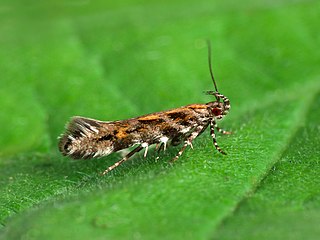
Aristotelia ericinella is a moth of the family Gelechiidae. It is found in most of Europe, except most of the Balkan Peninsula.

Bryotropha senectella is a moth of the family Gelechiidae. It is found throughout Europe.

Gelechia rhombella, the apple groundling, is a moth of the family Gelechiidae. It is found in Europe, the Caucasus, Transcaucasia, southern Siberia, the Russian Far East, Korea and China.
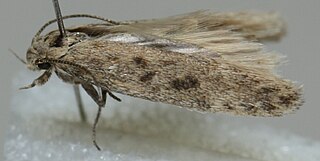
Scrobipalpa obsoletella, the summer groundling, is a moth of the family Gelechiidae. It is found in most of Europe, Turkey, the Caucasus, from Iran to Asian Russia (Transbaikal) and Mongolia. It has also been recorded from New Zealand, South Africa and North America, where it is probably an introduced species. The habitat consists of coastal salt marshes and sandy beaches.

Scrobipalpa instabilella, the saltern groundling, is a moth in the family Gelechiidae. It was described by John William Douglas in 1846. It is found in on the Canary Islands, in Algeria, Ireland, Great Britain, Portugal, Spain, France, Belgium, the Netherlands, Germany, Denmark, Italy, Sardinia, Sicily, Greece, Cyprus and Palestine. It is also present in the United States, where it has been recorded from California.






















